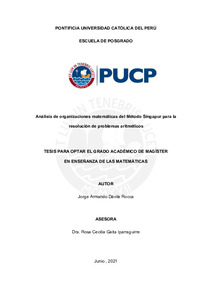| dc.contributor.advisor | Gaita Iparraguirre, Rosa Cecilia | |
| dc.contributor.author | Dávila Rocca, Jorge Armando | |
| dc.date.accessioned | 2021-08-03T19:06:12Z | |
| dc.date.available | 2021-08-03T19:06:12Z | |
| dc.date.created | 2021 | |
| dc.date.issued | 2021-08-03 | |
| dc.identifier.uri | http://hdl.handle.net/20.500.12404/19817 | |
| dc.description.abstract | El trabajo que se presenta a continuación responde a la siguiente pregunta de
investigación: ¿cuál es el alcance del método Singapur en términos de los problemas
aritméticos que permite abordar y cómo han sido organizados en la propuesta basada
en este método? Para ello, se presentan antecedentes que han evaluado la pertinencia
de la aplicación de la metodología de Singapur en países que lo han adoptado en sus
procesos de enseñanza. Las investigaciones más importantes sobre esta metodología
han sido llevadas a cabo en Singapur por el equipo de profesores de centros
educativos como National Institute of Education y Nanyang Technological University; en
Latinoamérica, sin embargo, no hay trabajos que profundicen específicamente sobre las
organizaciones matemáticas involucradas en la resolución de problemas. Este trabajo
pretende apuntar en ese sentido. El objetivo general de la investigación es identificar
una organización matemática de los problemas aritméticos abordados en una colección
de textos de primaria que siguen el modelo del método Singapur. Para ello, tomamos
como marco teórico a la teoría antropológica de lo didáctico en adelante (TAD),
propuesto por Chevallard (1999), que presenta la noción de praxeología. Es así como
las nociones de tipo de tarea, técnica, tecnología y teoría permiten modelar la actividad
matemática. Como resultado de nuestro trabajo, se presenta un Modelo epistemológico
de referencia (MER) para la clasificación de los problemas aritméticos, que permitan la
identificación de una organización matemática para estos problemas en los libros de
texto Prime Matemáticas de Singapur. | es_ES |
| dc.description.abstract | The following work answers the following research question: What is the scope of the
Singapore method in terms of the arithmetic problems it addresses and how have they
been organized in the proposal based on this method? The most important research on
this methodology has been carried out in Singapore by the team of teachers from
schools such as National Institute of Education and Nanyang Technological University
and in Latin America, however, there are no work that specifically delves into the
mathematical organizations involved in problem solving. This work aims to point in that
direction.
The overall objective of the research is to identify a mathematical organization of the
arithmetic problems addressed in a collection of primary texts that follow the Singapore
method model for this we take as a theoretical framework for the anthropological theory
of the didactics onwards (TAD) proposed by Chevallard (1999) that presents the notion
of praxeology, is as well as the notions of type of task , technique, technology and
theory allow us to model mathematical activity and allows us to study the mathematical
practices that are carried out in the so-called Singapore method. For this, we take as a
theoretical framework the anthropological theory of the didactic onwards (TAD),
proposed by Chevallard (1999), which presents the notion of praxeology. This is how
the notions of type of task, technique, technology and theory allow to model the
mathematical activity.
As a result of our work, we present an Epistemological Reference Model (MER) for the
classification of arithmetic problems, which allow the identification of a mathematical
organization for these problems in the Prime Mathematics of Singapore textbooks. | es_ES |
| dc.language.iso | spa | es_ES |
| dc.publisher | Pontificia Universidad Católica del Perú | es_ES |
| dc.rights | info:eu-repo/semantics/openAccess | es_ES |
| dc.rights.uri | http://creativecommons.org/licenses/by/2.5/pe/ | * |
| dc.subject | Matemáticas--Estudio y enseñanza (Primaria) | es_ES |
| dc.subject | Resolución de problemas | es_ES |
| dc.subject | Educación primaria--Perú--Investigaciones | es_ES |
| dc.title | Análisis de organizaciones matemáticas del Método Singapur para la resolución de problemas aritméticos | es_ES |
| dc.type | info:eu-repo/semantics/masterThesis | es_ES |
| thesis.degree.name | Maestro en Enseñanza de las Matemáticas | es_ES |
| thesis.degree.level | Maestría | es_ES |
| thesis.degree.grantor | Pontificia Universidad Católica del Perú. Escuela de Posgrado | es_ES |
| thesis.degree.discipline | Enseñanza de las Matemáticas | es_ES |
| renati.advisor.dni | 07757120 | |
| renati.advisor.orcid | https://orcid.org/0000-0002-7827-9262 | es_ES |
| renati.author.dni | 40406942 | |
| renati.discipline | 199117 | es_ES |
| renati.juror | Ugarte Guerra, Francisco Javier | |
| renati.juror | Gaita Iparraguirre, Rosa Cecilia | |
| renati.juror | Gonzales Hernandez, Cintya Sherley | |
| renati.level | https://purl.org/pe-repo/renati/level#maestro | es_ES |
| renati.type | http://purl.org/pe-repo/renati/type#tesis | es_ES |
| dc.publisher.country | PE | es_ES |
| dc.subject.ocde | http://purl.org/pe-repo/ocde/ford#5.03.01 | es_ES |






